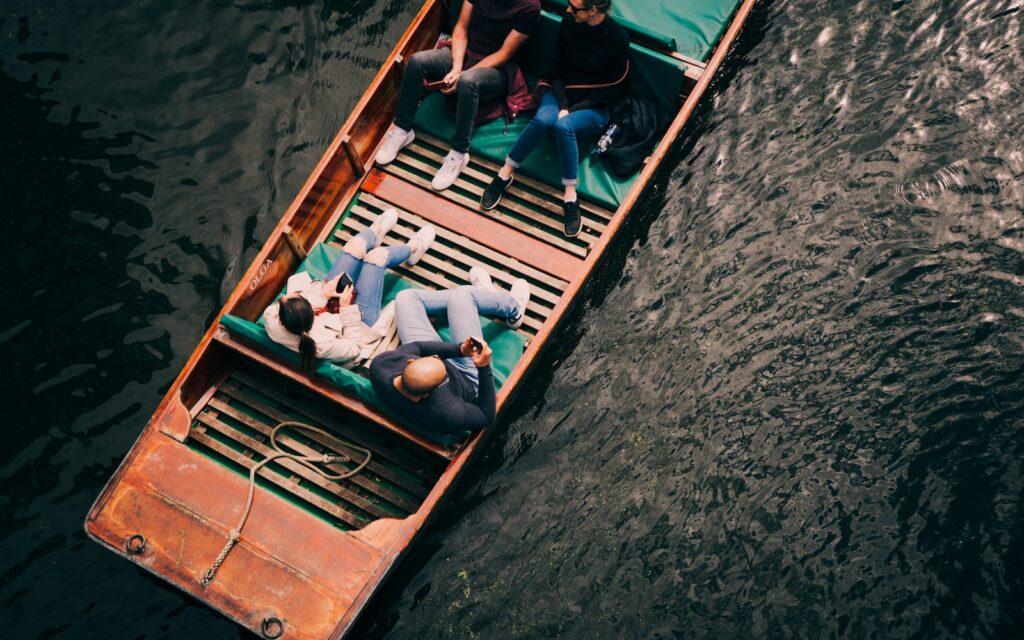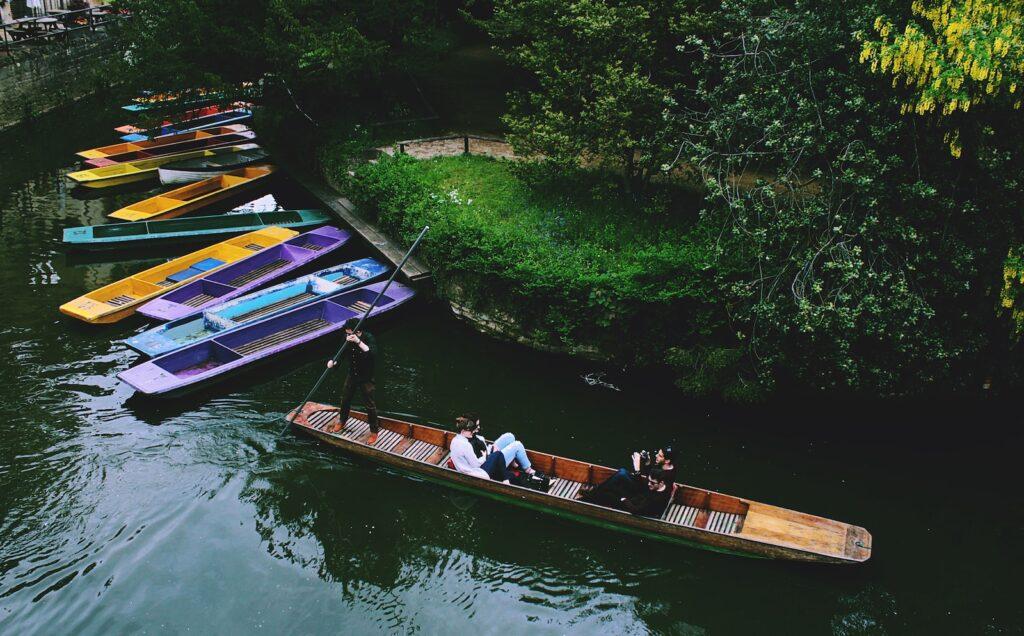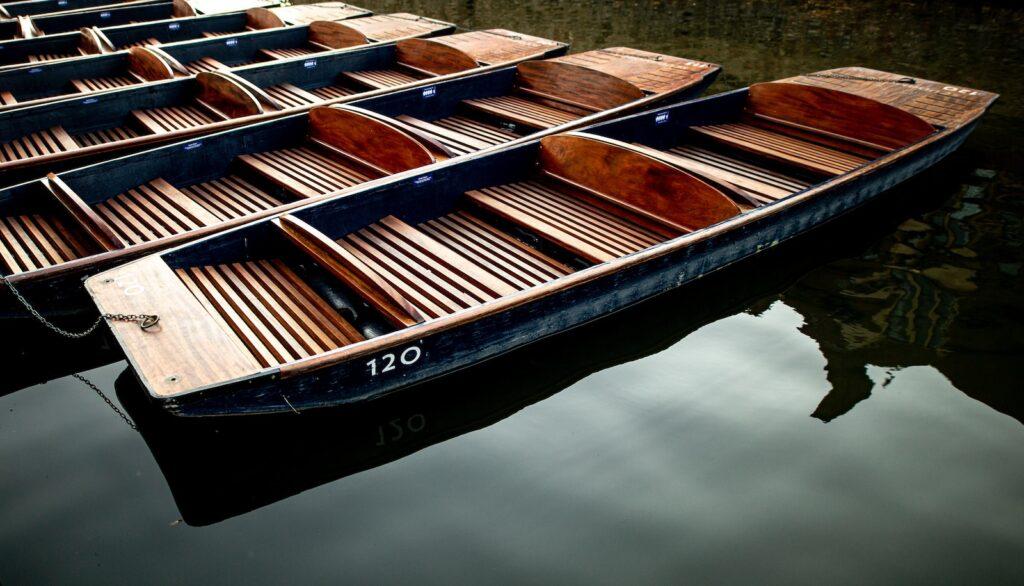What Is a Punt Boat
Key Takeaways:
Punt boats are traditionally flat-bottomed boats which means they have a flat bottom with no keel. This design allows them to be used in shallow waters, making them ideal for rivers, lakes, and marshes where other boats might run aground.
Punts are usually propelled by a pole—hence the term “punting.” The punter stands at the stern and pushes against the riverbed with the pole to move the boat forward. This method of propulsion is unique and requires skill and balance.
Punt boats have a rich history, especially in the United Kingdom, where they have been used for various purposes, including transportation, fishing, and even as platforms for duck hunting. Today, they are often associated with leisure activities and are a common sight in places like Cambridge and Oxford, where punting is a popular tourist activity.
Traditionally, punt boats were made of wood, but modern versions can also be made from materials like fiberglass for durability and ease of maintenance. The construction of a punt is relatively simple compared to other boats, with a flat platform and minimal draft, but they are still crafted with care to ensure stability and longevity.
Do you want to experience the freedom of gliding effortlessly across calm waters? Then a punt boat might be just what you need.
These versatile vessels have a rich history and are still popular today for various uses. Whether you’re a nature enthusiast, angler, or simply seeking a peaceful escape, a punt boat can provide you with the ultimate sense of liberation on the water.
Discover the wonders of this unique watercraft and embark on your own adventure.
Origins and History
Where did punt boats originate and how have they evolved over time?
Well, my friend, let me take you on a journey back in time. The origins of punt boats can be traced back to ancient times, where they were used by the Egyptians and Greeks for various purposes. These simple flat-bottomed boats were primarily used for transportation and fishing in shallow waters.
As time went on, punt boats evolved and adapted to the changing needs of different cultures. In England, for example, punt boats became popular in the marshy regions of the country, where they were used for navigating rivers and canals. These boats were typically made of wood, with a long pole used to propel them forward.
In more recent times, punt boats have gained popularity as recreational vessels. People now use them for leisurely rides and picnics on calm waters. They’ve also become a favorite among anglers, as their flat bottom provides stability and easy maneuverability.
Today, punt boats come in various shapes, sizes, and materials. You can find them made of fiberglass, aluminum, or even inflatable materials. Some even come equipped with electric motors for added convenience.

Design and Construction
Now let’s explore the different designs and construction methods used in building punt boats.
Punt boats come in a variety of designs, each suited for different purposes and preferences.
Here are the main design options you can consider:
- Traditional Punt: This design features a flat bottom and square ends, making it stable and easy to maneuver. It’s perfect for leisurely rides and fishing trips.
- Racing Punt: If you crave speed and adrenaline, the racing punt is your go-to choice. With a sleek, streamlined hull and a lightweight construction, it’s designed for maximum speed and efficiency.
When it comes to construction methods, punt boats offer flexibility and freedom. You can choose between different materials and techniques to build your perfect vessel. Here are the main construction options:
- Wood: Traditionalists often opt for wood as it offers a classic and timeless look. Building a punt boat from wood allows for customization and craftsmanship.
- Fiberglass: For a low-maintenance and durable option, fiberglass is a popular choice. It provides a smooth and sleek finish, making it ideal for racing punts.
No matter which design or construction method you choose, building your own punt boat allows you to embark on a journey of freedom and self-expression. So, go ahead and let your imagination run wild as you create your perfect floating companion.
Different Types of Punt Boats
Explore the various types of punt boats available to you, based on your specific needs and preferences. Whether you’re looking for a boat to leisurely cruise along the river or one that can handle rough waters, there is a punt boat out there for you.
| Type of Punt Boat | Features | Best For |
|---|---|---|
| Traditional Punt | Flat-bottomed with a square-cut bow and stern | Calm rivers and lakes |
| River Punt | Slightly narrower and more streamlined for faster maneuvering | Navigating rivers and small streams |
| Sea Punt | Sturdier construction with higher sides for stability | Coastal waters and larger bodies |
| Fishing Punt | Equipped with rod holders and storage compartments | Angling in lakes and rivers |
| Electric Punt | Powered by an electric motor for quiet and eco-friendly rides | Peaceful lakes and protected areas |
If you prefer a classic design and plan to use your punt boat on calm rivers and lakes, a traditional punt is the way to go. For those who enjoy navigating rivers and small streams, a river punt offers better maneuverability. If you’re planning to venture into coastal waters or larger bodies, a sea punt with sturdier construction and higher sides will provide the stability you need. Anglers will appreciate the features of a fishing punt, such as rod holders and storage compartments. Lastly, for a peaceful and eco-friendly ride, an electric punt powered by an electric motor is the perfect choice.
With these different types of punt boats available, you can find the one that suits your needs and desires for freedom on the water.

Uses and Applications
If you’re looking to experience the versatility and functionality of a punt boat, you can use it for both leisurely cruising along the river and navigating small streams. Punt boats are perfect for those who desire freedom and want to explore various waterways.
Here are some uses and applications of punt boats that will enhance your sense of liberation:
- Leisurely Cruising
- Enjoy a peaceful day on the water, soaking in the beauty of nature.
- Take in the sights and sounds of the surrounding environment while gliding effortlessly along the river.
- Exploring Small Streams
- Venture into narrow waterways that larger boats can’t access.
- Discover hidden gems and secret spots that are off the beaten path.
With a punt boat, you have the freedom to go wherever the water takes you. Whether you want to relax and unwind or embark on an adventure, this versatile watercraft allows you to do it all.

Pros and Cons of Punt Boats
Experience the advantages and disadvantages of punt boats before deciding if they are the right watercraft for you. Punt boats offer a unique and versatile way to navigate various bodies of water, but they also come with some drawbacks. Let’s explore both sides of the coin.
Advantages of Punt Boats:
| Pros | Cons |
|---|---|
| Easy to maneuver | Limited seating capacity |
| Shallow draft | Lack of protection from the elements |
| Versatile | Not suitable for rough waters |
Punt boats are known for their easy maneuverability, making them a great choice for those seeking freedom on the water. With their shallow draft, they can navigate in shallow waters where other boats cannot go. Additionally, punt boats are versatile, allowing you to use them for fishing, leisurely cruises, or exploring hidden coves.
However, there are a few drawbacks to consider. Punt boats typically have limited seating capacity, which may not be ideal for larger groups or families. They also lack protection from the elements, so you may need to plan accordingly for inclement weather. Lastly, punt boats are not suitable for rough waters, so if you enjoy more adventurous boating experiences, this may not be the right watercraft for you.
Consider these pros and cons before making your decision. Punt boats offer a sense of freedom and flexibility on the water, but they may not meet all your needs.
Wrap up
So, now you know what a punt boat is! With its origins dating back centuries, punt boats have evolved in design and construction to cater to various needs. From traditional wooden punts to modern fiberglass ones, there are different types available for different purposes.
Whether you’re a fisherman, a birdwatcher, or someone who just wants to relax on the water, punt boats offer a versatile and enjoyable experience. While they’ve their pros and cons, punt boats remain a popular choice for water enthusiasts.
